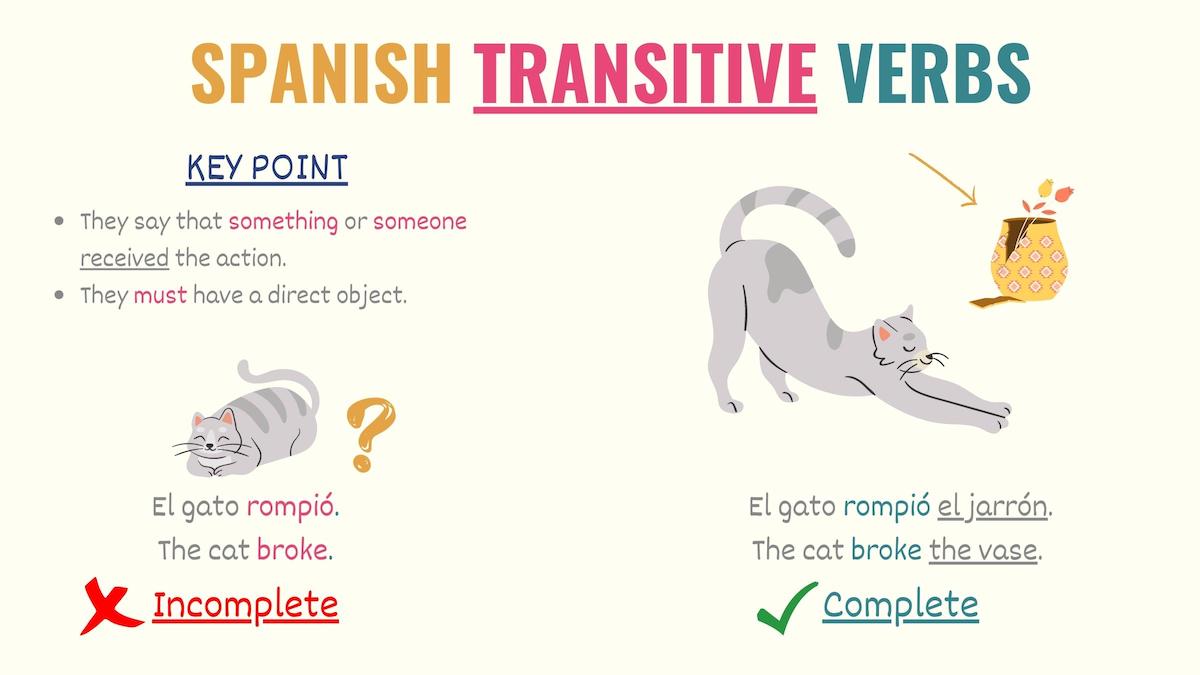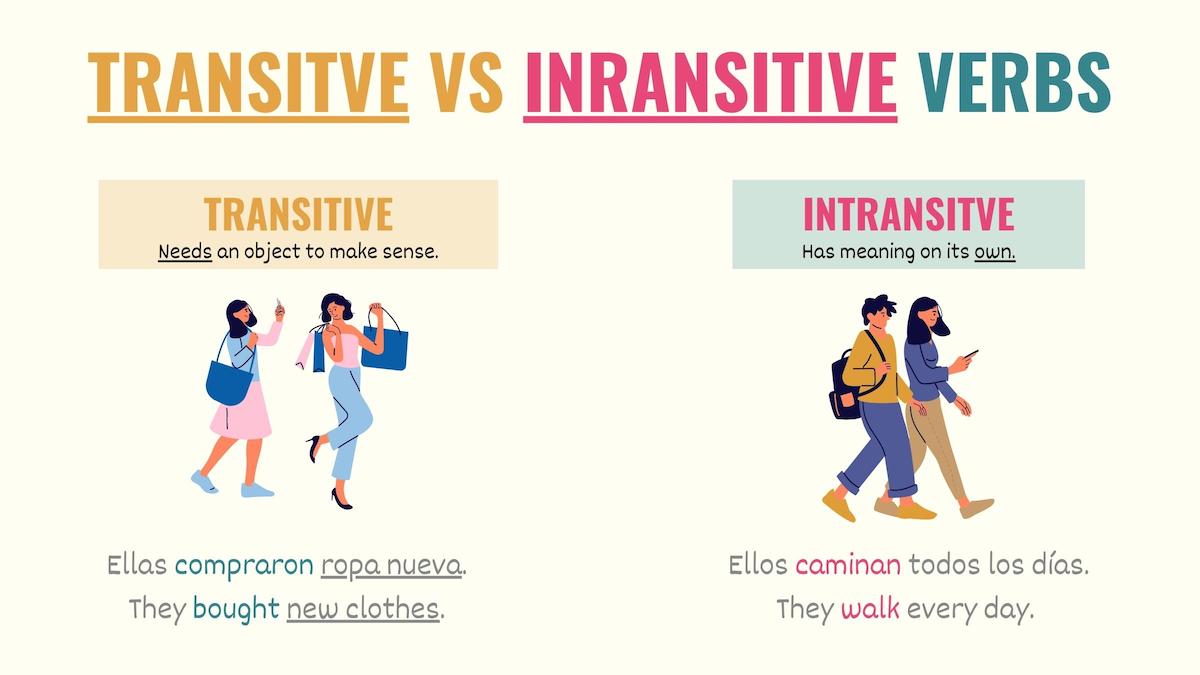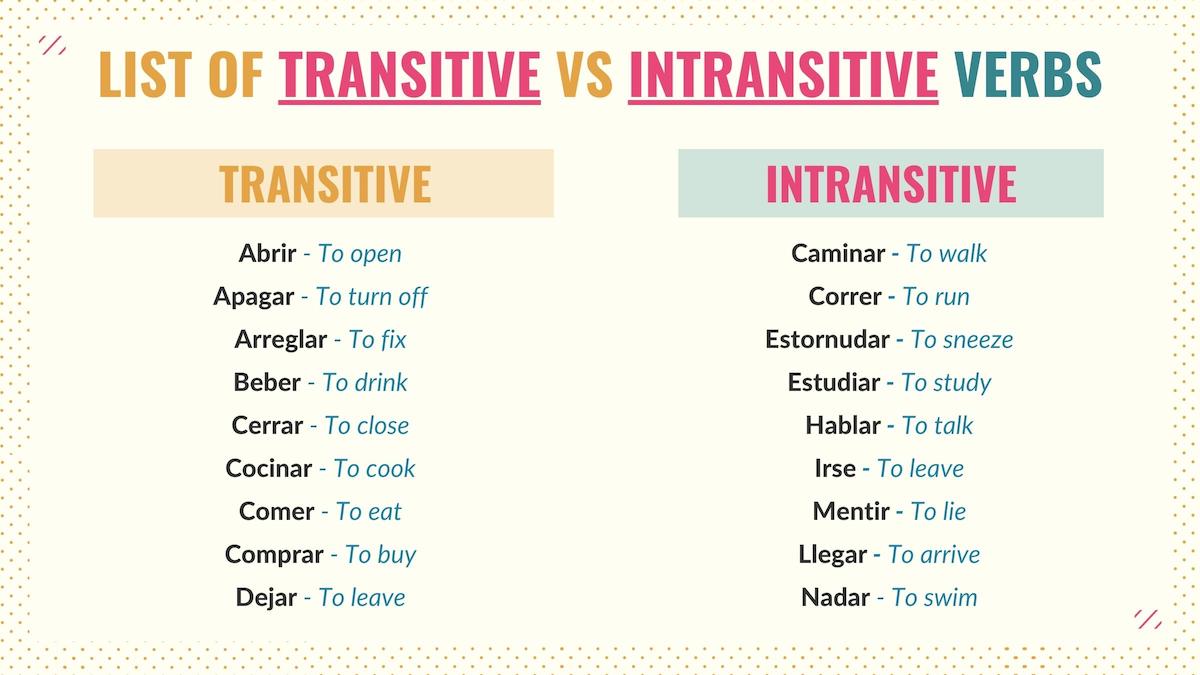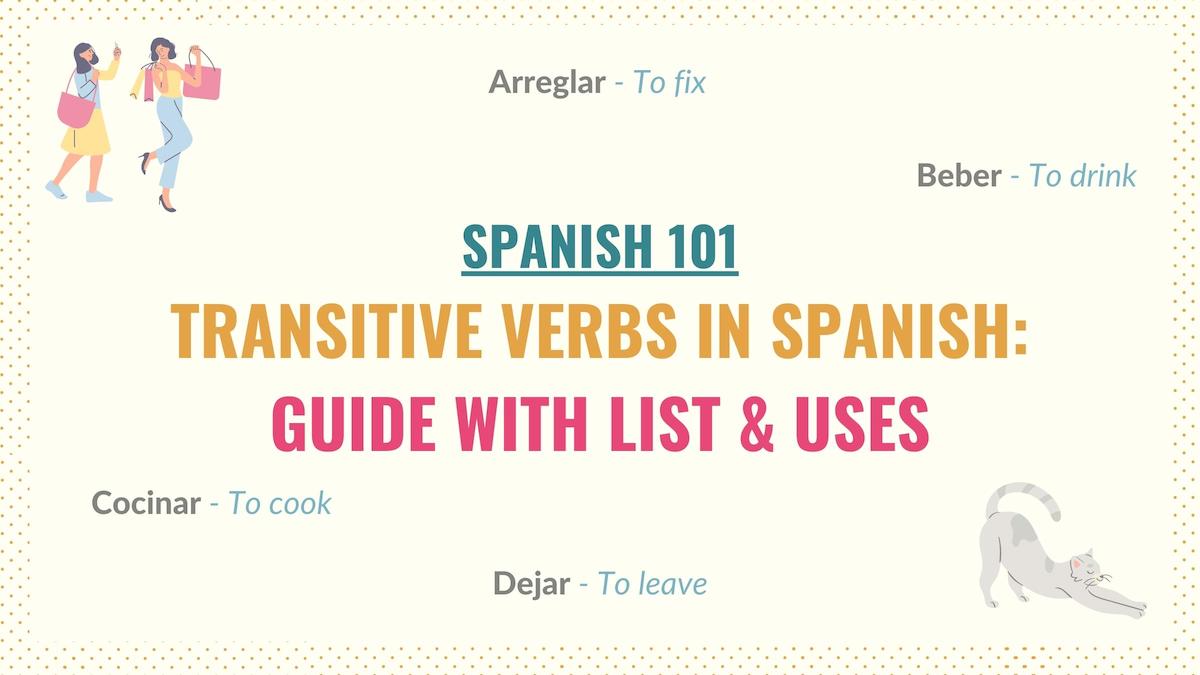Spanish transitive verbs are crucial to express that an action is directed towards something or someone. In short, you need to understand how these verbs work to create effective and clear sentences.
So, in this guide, we’ll learn more about how and when to use them. Here is a summary of what we’ll cover:
- What Is a Transitive Verb?
- Transitive vs Spanish Intransitive Verbs
- List of Spanish Verbs
- Key Points
- Additional Resources for Transitive Verbs
- Downloadable PDF
Let’s get down to business!
What Are Spanish Transitive Verbs?
In Spanish, a transitive verb is a verb that needs a direct object to complete their meaning. Put another way, this type of verb conveys that the action is directed towards something or someone. As a result, these verbs cannot stand alone.

Check these sentences with transitives:
[Verb] + [direct object]
Mi papá lavó el coche.
My dad washed the car.
Los niños rompieron el celular.
The kids broke the phone.
Quiero una flor roja.
I want a red flower.
The underlined elements from the previous sentences are direct objects. If you were to remove them, these examples would be incomplete because we wouldn’t know what my dad washed or what I want.
A transitive is part of your Spanish vocabulary. For instance, lavar and romper are both transitive because we must mention the person or thing that receives the action.
Like in English, in Spanish, a transitive verb can be paired with a direct object pronoun to replace the noun you’re talking about. For example:
| Full transitive sentence | Transitive sentence replacing the object |
|---|---|
| Yo vestí a la niña. I dressed the girl. | Yo la vestí. I dressed her. |
Direct object pronouns must agree in gender and number with the noun they replace. In this case, we use la (singular feminine) because niña is a singular feminine noun. However, if we needed to replace niño, you would need to use el.
Transitive vs reflexive verbs in Spanish
Spanish reflexive verbs are also transitive. However, we only use them when the direct object refers back to the subject. In simple terms, when the subject acts on itself:
[Reflexive pronoun] + [verb]
La niña se vistió ella misma.
The girl got dressed.
Yo me peino todas las mañanas.
I brush my hair every morning.
Take Note: Notice that these verbs cannot always be translated into English. Additionally, reciprocal verbs can also be transitive because people act on each other. Even though a pronominal verb uses reflexive pronouns, they’re not always transitive.
Difference Between Transitive and Intransitive Verbs in Spanish
A verb can be transitive or intransitive depending on whether they have a direct object. As mentioned above, a transitive verb must have an object to complete its meaning. On the other hand, Spanish intransitive verbs do not have an object. As a result, they can stand alone in a sentence.

Check these phrases using intransitive verbs in Spanish:
Yo trabajo aquí.
I work here.
Yo dormí muy bien.
I slept very well.
Ese bebé nunca llora.
That baby never cries.
Ashley nada todos los días.
Ashley swims every day.
In Spanish, a sentence formed with these verbs can contain adverbs to describe how well someone does this action.
Take Note: Some verbs, like dormir, that can take an object (transitivity) or be intransitive and have a full meaning on their own (like example #2).
Spanish Vocabulary: Intransitive & Transitive Verb List

Now that you understand the characteristics of these verbs, you should check this list to improve your verb vocabulary. To make things easier, this list has been divided into transitive and intransitive examples. If a verb is followed by an asterisk it means that it can be either.
Common transitives:
- Abrir: To open
- Apagar: To turn off
- Arreglar: To fix
- Beber: To drink
- Cerrar: To close
- Cocinar: To cook
- Comer: To eat
- Comprar: To buy
- Dejar: To leave
- Escribir*: To write
- Esperar: To wait
- Hacer: To do / To make
- Leer*: To read
- Limpiar: To clean
- Llevar: To take
- Peinar: To comb
- Prender: To turn on
- Probar: To taste
- Traer: To bring
- Vender: To sell
- Ver: To watch / To see
- Vestirse: To get dressed
Check these sentences:
¿Quién abrió la puerta?
Who opened the door?
Will dejó sus llaves en la mesa.
Will left his keys on the table.
¿Y el perro? No lo he visto.
And the dog? I haven’t seen him.
Las galletas estaban buenas, ¿las probaste?
The cookies were good. Did you try them?
Examples of intransitives:
- Caminar: To walk
- Correr: To run
- Dormir*: To sleep
- Entender*: To understand
- Estornudar: To sneeze
- Estudiar: To study
- Gritar*: To yell / To scream
- Hablar: To talk
- Irse: To leave
- Mentir: To lie
- Llegar: To arrive
- Nadar: To swim
- Pensar: To think
- Reír: To laugh
- Recordar*: To remember
- Respirar: To breathe
- Salir: To exit / To leave
- Trabajar: To work
- Vivir: To live
Nosotros salimos temprano.
We leave early.
Simone vive en Argentina.
Simone lives in Argentina.
Marianne no ha llegado.
Marianne hasn’t arrived.
Helen habló con el director.
Helen spoke to the director.
Key Points
Transitive verbs are key in the Spanish language for conveying clear and complete messages. Here are some important rules you should never forget:
- A transitive verb expresses that the action is directed toward something or someone.
- As a result, they cannot stand alone.
- In Spanish, a reflexive verb is an example of transitive verbs. In this case, the object and subject are the same.
- On the other hand, an intransitive verb has meaning on its own.
Additional Resources for Transitive & Intransitive Verbs
Given that these verbs work with a direct object, your next step should be to get familiar with the Spanish direct and reflexive pronouns. Additionally, sentences with transitive verbs often express to whom we’re giving the direct object.
So, you will also need to understand how indirect and double object pronouns are used. Finally, you also need to learn Spanish adverbs so you can describe how an intransitive action is being done.
Download the PDF Cheat Sheets
It can be difficult for Spanish beginners to remember all the rules as well as the list of transitive & intransitive verbs. I’ve put together a PDF you can download containing the graphics, example sentences and key points from this guide.



